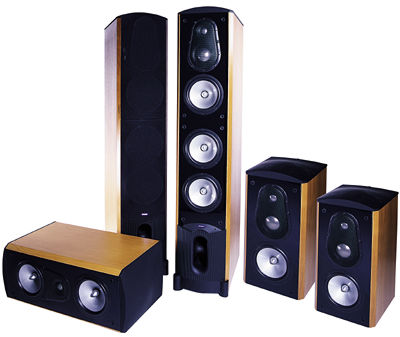Energy Veritas V2.4 surround speaker system
Inside and Outside
The Veritas V2.4's 6.5-inch woofers have dual voice coils wound in opposite directions (thus the designation Dual-Hyperdrive). Each coil is situated in its own magnetic gap; operating them in tandem is said to significantly reduce distortion. The cone is made of a special composition designed to optimize weight, stiffness, and damping. A phase plug of solid aluminum eliminates the dustcap—a possible source of coloration—and helps dissipate heat.

The two aluminum-dome drivers that cover the range from the upper mids to the treble—Energy calls them the Convergent Source Module—are superficially similar to the arrangement in the Veritas V2.8. But the midrange dome is smaller and crosses over at 550Hz and 2kHz (the V2.8 has a 3-inch dome mid with 380Hz and 2.5kHz cross-
over points). The 2kHz crossover frequency should, in principle, produce better dispersion, but a tweeter must be carefully designed to extend this low in frequency without risk of damage.
Energy refers to the Veritas V2.4's crossover as a Tapered Crossover System. One of the woofers responds up to 150Hz, the second to 300Hz, the third to 550Hz. Thus all three are engaged in the lowest frequencies, but only one extends up into the midrange. This should enhance dispersion and minimize audible interference—lobing—between the three 6.5-inch drivers.
The Veritas V2.0C center-channel speaker is a two-way, three-driver design using two 6.5-inch Dual Hyperdrive woofers and a single 1-inch tweeter. It, too, has a Tapered crossover; to minimize lobing, only one of the woofers responds up to the tweeter crossover point of 1.8kHz.
The V2.0R surround may be the most innovative speaker in the Veritas line. Energy has provided it with so much flexibility that they've given the technology its own name: the Soundfield Management System. A switch lets you select among three setup options: Bipole, Dipole, and Corner. In Dipole or Bipole mode, all four drivers—a front-mounted 6.5-inch woofer and 1-inch tweeter and two side-firing 3-inch Mid-Band Fill drivers—are active. The side drivers are in phase in Bipole mode and—surprise—out of phase in Dipole. A level control adjusts the output of the side drivers from off (Min) to 1dB below the output of the front drivers (Max). In the Corner setting, the fill driver on the side nearer the control panel is switched off. This configuration is recommended for systems in which the surround speakers must be positioned so near a corner that the side driver would be firing immediately into the adjoining wall, inviting serious coloration.
All Veritas loudspeakers have rigid, heavily damped enclosures. The rear of the each woofer's magnet is braced against the back of the cabinet with a threaded rod; the nuts securing these rods are on the outside of the cabinet, covered by visible rubber caps. The Convergent Source Module has its own damped sub-enclosure, and low-diffraction grilles are provided (in my auditioning, I used the grilles only on the surrounds).
Each Veritas speaker is also equipped for biwiring or biamping, though for my listening I used single-wire connections throughout. Energy provides spikes, but the narrow-baffled V2.4 is a slightly top-heavy, and a little unstable. While the speaker is unlikely to tumble over in normal use (though I wouldn't bet on it in an earthquake), I recommend caution if children are likely to be nearby. Energy might want to consider providing wider feet—outriggers—to enhance the V2.4's stability. A concerned and resourceful owner could make such feet with a few pieces of hardwood and a little ingenuity.
Moving Into Position
I broke in the Veritas system for about two weeks in my Review System 1 before moving it into System 2 for extended critical listening. The V2.4 L/Rs faced down the 26-foot length of the larger room and were about 8 feet out from the short wall behind them and a minimum of 2 feet from the sidewalls. They were about 9 feet apart and toed-in toward the center. The V2.0C center was placed under the projection screen on a 1-foot stand. The V2.0R surrounds were mounted above ear height on the sidewalls, approximately 120° back from the forward (center-channel) position. After determining that the V2.0Rs worked best as bipoles with my room and setup, I used that setting throughout the auditioning.
- Log in or register to post comments






























































